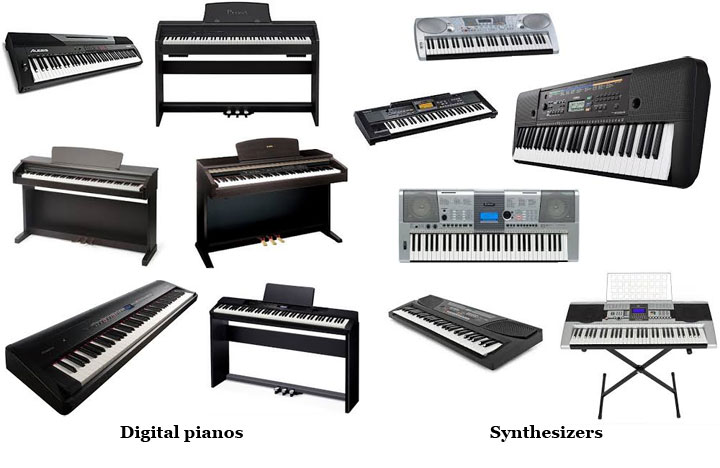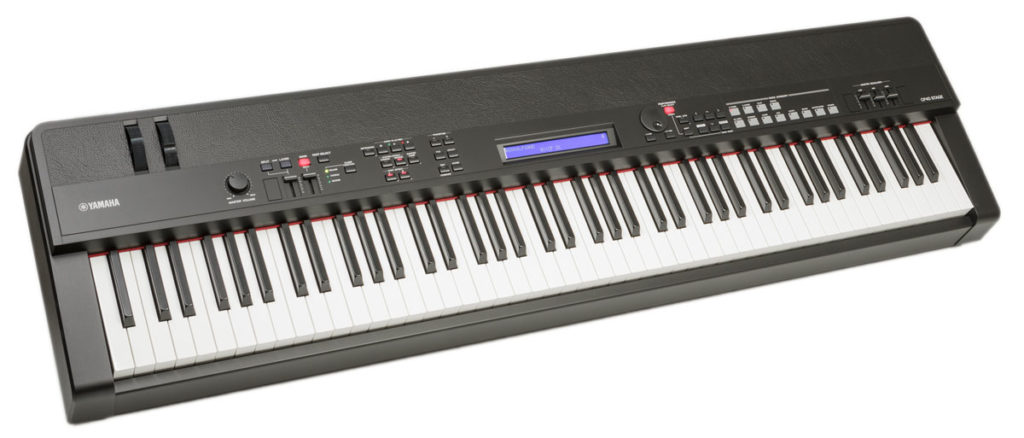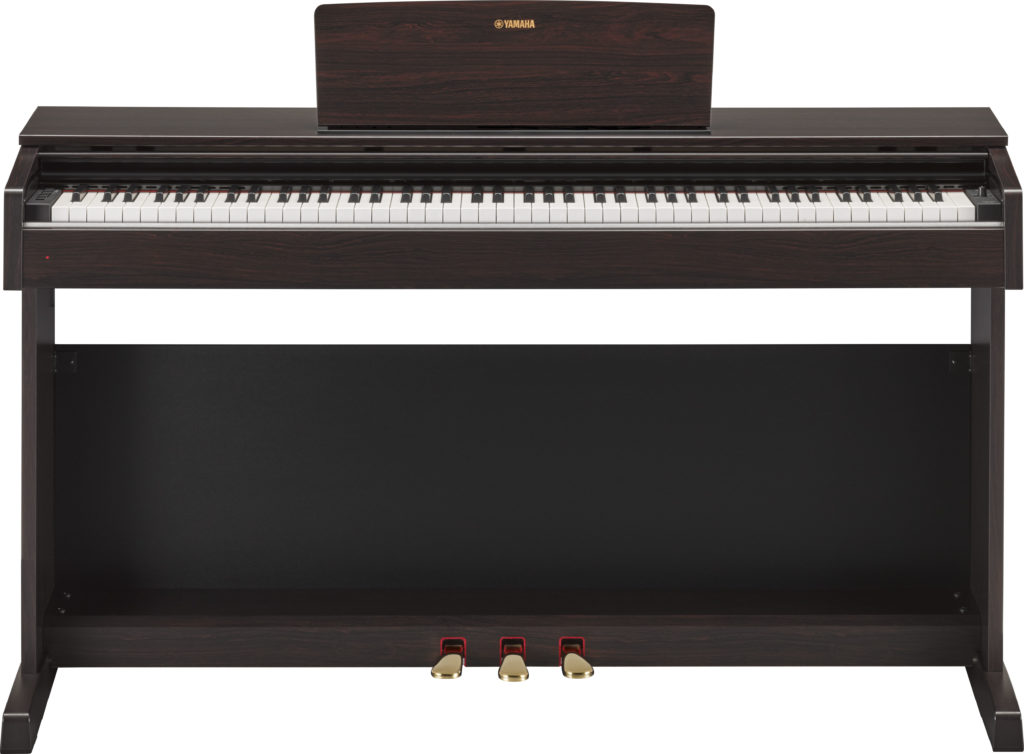You must be a piano enthusiast like I am to be interested in this topic. Among the most confusing terms when it comes to this wonderful instrument are electronic keyboard and digital piano. These are two different things but many people do not seem to be able to tell the difference. Do not worry though, I am here to help bring some clarity into the matter. So let’s see what is the difference between a digital piano and an electronic keyboard?

Basically, a keyboard is a part of a piano. In an acoustic piano, the board at the top containing black and white keys is the keyboard. The keyboard is not an instrument but a part of another instrument. Keyboards may be part of a digital piano or a synthesizer. A synthesizer generates electric signals which are converted into sound via amplifiers and speakers. It can imitate the sound of many natural sounds including the piano. This is why many people confuse electronic keyboards with synthesizers. Nowadays many people call any instrument that has black and white keys a keyboard. There is no musical instrument called a keyboard. But due to frequent use of the term electronic keyboard can be used to refer to a synthesizer. Even makers of synthesizers nowadays sell them as electronic keyboards. So, nowadays electronic keyboard most often means electronic synthesizer – a device which generates sounds when you press keys.
A digital piano, just like synthesizer, is an electronic musical instrument that is played using a keyboard. Unlike acoustic pianos that use hammers and strings to create sound, digital pianos create sound from sampled piano sounds or synthesize an emulation of the piano sound electronically. Each brand (Yamaha, Alesis, Williams, Casio, Korg, Kurzweil) has more expensive models, which sound and feel like the actual acoustic pianos but are lighter in weight and occupy less space.
How can you know whether an instrument is a digital piano or an electronic keyboard? Both of them synthesize sounds and look similar. Here are some features to look for.


- Number of keys
You do not need to count all the keys to know how many they are. Just create a picture of a grand piano in your mind and on first look you will know if you are looking at a digital piano or electronic keyboard. Digital pianos have 88 keys with 6 octaves just like there are on acoustic pianos. This way they are able to create sound range just like that of a real piano. On the other hand, electronic keyboards have 61 or 76 keys with 4 to 5 octaves, or sometimes even less.
- Weighted keys
A good digital piano comes with weighted keys whereas an electronic keyboard does not. Weighted keys are made in such a way that they respond to the amount of force applied by the finger pressing on a key. The sound is louder when the key is pressed harder and softer when pressed lightly. The keys are lighter at the top notes and heavier at the bottom. This makes it sound more like an acoustic piano. In synthesizers, the keys are either light- or semi-weighted – they are easier to press, because you most often don’t need the feeling of real piano when you play synthesizer.
- Size of keys
On digital pianos, the keys are the same size like in an acoustic piano but in an electronic keyboard or synthesizer the keys are often a little smaller in size. This means that electronic keyboards are easier to learn and play while digital pianos take longer and harder to learn. If you are a seasoned pianist like me however you may find it a little difficult to adjust to small size of the synthesizer.
- Portability
Due to the keys being fewer and smaller, synthesizers are smaller than digital pianos. The smaller an item the easier it is to carry it around. This is to say that electronic keyboards are more portable. They are lighter in weight and many musicians carry them from one place to the other. Digital pianos can also be easily moved from one place to the other but not with as much ease as synthesizers can.
- Sounds
Digital pianos, as it comes from the name, are mostly created to synthesize piano sound. There shouldn’t be just one sound. There can be a lot of different sounds integrated: bright piano, grand piano, lot’s of electric piano sounds, etc. These are sounds sampled specially for digital pianos. Often there are some other acoustic instruments sounds included such as strings, bass, organ.
An electronic keyboard on the other hand has the sounds of a piano and other acoustic instruments as well, but on cheap models they are not as well sampled. Synthesizers however can make much more sounds and tones than pianos. There are many synth tones, some with physical instrument equivalent and others without.
- Appearance
Sometimes synthesizers look just like digital pianos – same keyboard, similar control buttons etc. But there is special class of home console digital pianos. You don’t have to buy keyboard stand for them, because they are already integrated into wood-like body. They look very beautiful and can be easily integrated into your room design (see Yamaha YDP Series).

- Price
Prices are very different. You can buy an expensive synthesizer for $2000, or a cheap digital piano for $200, and vice versa. This depends on what you want from your device. If you are serious about playing the piano however, then digital piano is the right instrument to invest in. If you are planning to experiment with sounds or create electronic music – you should look for a good synthesizer.
Couple of words about workstations
I should say that there are expensive synthesizers (called workstations, for example Yamaha MOXF8, Roland JUNO-DS88, Korg Krome), which have all the features of digital pianos and synthesizers in one body: they have 88 full size fully weighted keys, and have a lot of sounds of both acoustic and electronic instruments.

You can also create and upload your own sounds to them, record your tracks, and much more. But these devices are usually expensive and are for professionals.
As for me, I recommend that my younger students start to learn on digital pianos from the very beginning. This way they can be sure that if they play on a grand acoustic piano some day, they won’t be confused too much of all that things I described – the number, size, and weight of keys, as their training instrument has similar specifications.
your blog provided helpful information for beginners like Price, appearance, number of keys in the keyboard etc. Thanks for such a great description of Digital piano and keyboard.
I have a Yamaha Clavinova CLP-153SG Digital Piano. When I play notes in the lower octaves they sound fine, but when I play chords they sound distorted. I thought there was something wrong with the piano so I brought it in to be fixed, but the repair guy said it was fine and whenever I try an electric piano in a store it’s the same result. Is this endemic with electric or digital pianos, or is it just me? My wife agrees with me that it sounds terrible. Help!
Hi Mark. There should be no distortion on piano voices, the piano should sound just like a usual acoustic instrument. Does it sound the same if you use headphones and speakers?
Hi. Can I connect MIDI system to a digital piano to experiment with sounds or create electronic music? Thank you.
Hi Rustam!
Not every digital piano supports MIDI, you should check the model’s specifications to see it.
Thanks for your explanation on differnce between a digital piano a synthesizer . I need most of the features a synthesizer has in a digital piano . Things like styles tempos ,ability to create etc. And to have maximum keys closer to 88. With your explanation closest is a work station isnt it. Any recommendations from Yamaha for me to research further before purchase . Regards
Hi Trevor,
If you are Yamaha fan, then I would recommend you to check DGX-660. It is very feature rich and I can call it some kind of universal “two in one” device: digital piano+synthesizer.
Hi, I’m new to learning the piano I took my very first lesson last week, I need to buy one so I read your post and it is helpful, my instructor insisted that if I buy one it should have weighted keys
so can you recommend me something that is not too expensive, from your post the electric ones have semi weight feature, will that also work in my case?
Hi Asma,
I don’t recommend buying semi-weighted keyboards if you are planning to study seriously, better look for weighted keyboards.
Look at my list of the best pianos priced around $500. I would choose between Yamaha P-45, Korg B2, Casio Privia PX-160.
I am still confused after reading your blog. I need to get something for my 5 yr old daughter. She will be learning at home only .. mostly with youtube and other online videos.
What would you suggest to buy for her ? I need something portable.
First of all you should decide if your daughter is serious in learning or just wants to try it.
Judging the fact that she is going to learn by youtube I believe that she is not very serious and any budget Casio or Yamaha synthesizer will be enough at least for the first couple of years. I recommend checking Casio CTK series or Yamaha PSR.
If your budget is not limited, then go for Yamaha DGX-660 – very feature rich digital piano with great sound and weighted keys.
I am at this point in time using a Yamaha PSR-190 and am playing a number of tunes by reading from sheet music downloaded from a site. The unit has many different voices as they are called, along with many styles and tempos, ranging from Reggae to Waltz , but many of the styles are heavy on the drum section. I am looking for an improved version of the unit with a softer rythem section and clearer sound, as this unit was used as a toy and has suffered much abuse. What would you suggest I do. I am considering replacing it , but I am not sure if I should stick with Yamaha or go with Roland. I need a unit that provides smooth balanced accompaniment for the tunes I am playing, Samba, Merengue, Reggae Waltz Bossa nova and calypso.
Hi Charles,
If the budget allows, I would choose DGX-660, it has a huge number of sounds, styles and rhythms. But it is quite expensive and also very heavy. If you are looking at a device similar to your good old PSR-190, just more modern, then there are models in the PSR series. My personal favorite in this series is the PSR-EW300. Check here my review of the most popular Yamaha keyboards, I talk about both of these models there.
Hello John,
Thank you so much for reminding the importance of the weight of the keys. My six year old daughter shows great interest in playing piano. Her teacher recommended not to buy an electronic one. We are thinking to buy a digital one before going forward to an acoustic piano. Two digital pianos we are considering are Yamaha YDP 184 R and YDP S54.
Would you kindly advise?
Thank you in advance!
Hi Rebecca,
Both pianos are good. YDP 184 is a bit better by specifications and as per me it looks more stylish then S54. So if the budget is not a problem, then I would go for the first one. The keyboard action in these two pianos is the same, but 184 has more polyphony voices (256 vs 192), more instrument voices and rhythm patterns. But note that YDP 184 also weighs much more and is rather bulky.
Hello John,
Thank you for your prompt reply!
Would you say YDP 184 performs more like an acoustic piano compared to S54? For a kid or a beginner to get more acoustic like experience, would you recommend YDP 184?
Thanks
Hello
I am an adult and planning to buy a basic digital piano for recreational purpose. Not very serious learning. I have never played piano till now. I am thinking of buying Artesia Harmony Studio Digital Piano sold in Costco. What are your thoughts about it.
Thank you.
Thank you so much.
I’d love to have a s m a l l digital piano with weighted keys in my summer house, where I cannot have an acoustic piano.
Do you know of any – that have only 61 keys, possibly 73 – I do not have room for more…
Speakers built in, for practical purposes (transport when going somewhere to play).
I do not play the piano sadly but am fascinated by music involving digital pianos and synths. Your arrival is so logical and easy to understand.
Thank you.
I am a violinist, and my sister is now playing her first real instrument for the first time, and neither of us have an idea whether it is a synthesizer of E. Piano. My younger sister and I are trying to identify her new Synthesizer/E. Piano. She got it new for Christmas 2021 from our parents, but still aren’t sure even after reading this article.
It has 61 total keys, like a synthesizer, buttons that can make it sould like a piano, an electronic piano, an organ, a harpsi-cord (I THINK I spelt that correct😅), and a button that can make it sound like any string instruments.
There is a button to change how loud the volume is, a button able to change the tone to several different tones, an button to add a variety of rhythm’s and songs, a record and play back button, a set-up button, and a function button.
It also has a headphone jack and two different wire jacks. It also comes with a plastic, detachable music stand (just some extra information). The keys only make sound when turned on, and doesn’t make a difference when you press around the edge or the beginning of the keys (if that makes sense). The brand is CASIO/Casiotone (CT-S100).
But it doesn’t have any sound effects, sound effects. Like my ELA teacher and Orchestra instructor both said that many synthesizers have sound effects like a Helicopter as an example, or a siren, and such. We’re a little mixed up because it has many features like a synthesizer AND like a electronic piano. So of you could tell the difference, and simply tell whether its a synthesizer or electric piano, please do let me know. I would appreciate it very much.
Hi Maya!
The device you are talking about (Casiotone CT-S100) is an entry-level synthesizer. Having just black&white keys and piano sound doesn’t make the device a piano. As I described in the article above it has all the distinctive properties of the synthesizer: non-weighted keys (the keys on your device are light-weight if compared to the piano, they are easy to press), the keys are not touch-sensitive (no matter how hard you press the key, it will always sound at the same volume), the keyboard itself is very light-weight (you won’t find digital piano below 7 kg, because the weighted keys mechanism itself weighs a lot).
But actually it doesn’t matter if it is a synthesizer or a digital piano. The most important thing is that your sister likes playing it! As this is her first instrument, she should have fun with it, and probably later she will replace it with a digital piano, or you even buy her an acoustic one:)
What a great topic, you answered all my questions I had in my mind
Thank you 😊
Hi ! Between PSR 295 and NP 11, which one can I go for? For musical shows?
Hi Adura,
Actually both of these keyboards are no longer in production, and PSR-295 as far as I know is from 2004… I would suggest something more modern such as PSR-E series (for performing various styles) or NP-12 (mostly for piano performances).